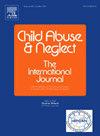The association between childhood maltreatment and school bullying behaviors among Chinese adolescents: A latent class analysis
IF 3.4
2区 心理学
Q1 FAMILY STUDIES
引用次数: 0
Abstract
Background
Existing studies primarily examine the relationship between childhood maltreatment (CM) and bullying behaviors from an accumulative perspective. However, there is limited understanding of this relationship when adolescents experience combined forms of childhood maltreatment, particularly in the context of varying residential environments.
Objectives
This study aimed to identify latent patterns of childhood maltreatment and examine their association with bullying behaviors among Chinese adolescents. Additionally, residential area differences in these associations were explored.
Participants
There were 13,029 Chinese adolescents (mean age = 14.4 years) who completed self-report questionnaires between October and November 2023.
Methods
Data on childhood maltreatment and school bullying were collected through self-report measures. Latent class analysis (LCA) was employed to identify distinct patterns of maltreatment. Multiple logistic regression was employed to explore the relationship between maltreatment patterns and bullying behaviors, with stratified analysis conducted by residential areas after propensity score matching (PSM).
Results
Three childhood maltreatment patterns were identified: low-abuse-low-neglect (class 1, 75.7 %), low-abuse-high-neglect (class 2, 20.9 %), and high-abuse-high-neglect (class 3, 3.5 %). Compared to class 1, class 2 was associated with elevated risks for being an only victim (OR = 1.68), only bully (OR = 1.57), or bully-victim (OR = 1.85). Class 3 showed even higher risks (only victim: OR = 3.71; only bully: OR = 4.79; bully-victim: OR = 7.95), with a clear gradient in risk severity. Stratified analyses revealed that adolescents in rural areas who primarily experienced neglect were more likely to be both bullies and victims compared to the urban adolescents (OR = 2.05, 95 % CI = 1.17–3.58, p < 0.05).
Conclusions
Childhood maltreatment influences bullying behaviors among adolescents significantly, with distinct maltreatment patterns providing critical insights for risk stratification. Residential area differences further modulate these associations. Intervention strategies should account for diverse maltreatment patterns and contextual factors such as rural-urban disparities to effectively address bullying behaviors.
中国青少年童年虐待与校园欺凌行为的关系:一个潜在阶级分析
背景现有研究主要从累积的角度考察儿童虐待与欺凌行为的关系。然而,当青少年经历各种形式的儿童虐待时,特别是在不同的居住环境中,对这种关系的理解有限。目的探讨中国青少年儿童虐待的潜在模式及其与欺凌行为的关系。此外,研究还探讨了这些关联的居住区域差异。参与者在2023年10月至11月期间完成了13029名中国青少年(平均年龄= 14.4岁)的自我报告问卷。方法采用自述法收集儿童虐待和校园欺凌的相关数据。潜在类别分析(LCA)用于识别不同的虐待模式。采用多元logistic回归分析虐待方式与欺凌行为之间的关系,并采用倾向得分匹配(PSM)方法对居住地进行分层分析。结果发现三种儿童虐待模式:低虐待-低忽视(1类,75.7%)、低虐待-高忽视(2类,20.9%)和高虐待-高忽视(3类,3.5%)。与1级相比,2级与成为唯一受害者(OR = 1.68)、唯一欺凌者(OR = 1.57)或欺凌受害者(OR = 1.85)的风险增加有关。3级甚至更高的风险(仅受害者:OR = 3.71;独霸:OR = 4.79;欺凌受害者:OR = 7.95),风险严重程度有明显的梯度。分层分析显示,与城市青少年相比,主要经历过忽视的农村青少年更有可能成为欺凌者和受害者(OR = 2.05, 95% CI = 1.17-3.58, p <;0.05)。结论童年虐待对青少年欺凌行为有显著影响,不同的虐待模式为风险分层提供了重要见解。居住区的差异进一步调节了这些联系。干预策略应考虑到不同的虐待模式和背景因素,如城乡差异,以有效解决欺凌行为。
本文章由计算机程序翻译,如有差异,请以英文原文为准。
求助全文
约1分钟内获得全文
求助全文
来源期刊

Child Abuse & Neglect
Multiple-
CiteScore
7.40
自引率
10.40%
发文量
397
期刊介绍:
Official Publication of the International Society for Prevention of Child Abuse and Neglect. Child Abuse & Neglect The International Journal, provides an international, multidisciplinary forum on all aspects of child abuse and neglect, with special emphasis on prevention and treatment; the scope extends further to all those aspects of life which either favor or hinder child development. While contributions will primarily be from the fields of psychology, psychiatry, social work, medicine, nursing, law enforcement, legislature, education, and anthropology, the Journal encourages the concerned lay individual and child-oriented advocate organizations to contribute.
 求助内容:
求助内容: 应助结果提醒方式:
应助结果提醒方式:


